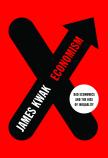What Econ 101 gets completely wrong
James Kwak is a brilliant young law professor, economics blogger and successful entrepreneur. His new book is a slim little volume that calmly and clearly blows up the major premise of most conservative policy-making—and much of the Democratic Party’s policy agenda as well.
Kwak’s target is “Econ 101,” the introductory course in economics that, for the majority of college graduates, is the only exposure to the subject that they get. Their textbooks uniformly present a world driven entirely by “supply-and-demand” curves. It is a world where an invisible market dance mediates the adjustments of volumes and prices that are infallible as human institutions can be, a shining example of the wisdom of crowds.
So long as the principles of Econ 101 are applied to easy-to-understand choices, like buying a television set or a movie ticket, or picking out a restaurant, they work fine. But when they are used to drive more complex decisions—Kwak’s examples all involve important public policies—they are often found wanting, even wildly inappropriate.
Consider the debates over setting minimum wages. It is a truth universally acknowledged that increasing the minimum wage costs jobs. U.S. House Speaker Paul Ryan, along with almost all other Republicans and business leaders, firmly believes that raising the minimum wage “will hurt the economy because it raises the price of labor.” And a rising price of labor—according to the supply-and-demand curves of Econ 101—will force businesses to shed employees or decrease investment.
In fact, mainstream economists have devoted a vast amount of research to precisely this question over the past decade, and have basically split down the middle over the question. Minimum-wage increases definitely transfer money from business owners to low-income workers, which is the whole point, but there are about as many studies showing that they have no impact on employment numbers as there are studies that do find an effect. Common sense suggests that employment effects will vary based on the size of the mandated increase, the state of the economy and multiple other factors; but in the normal case, the employment effect, if any, is small.
Kwak reels through a Baedeker Guide of Econ 101 “truths.” For instance, increasing taxes on the wealthy, all Republicans and many Democrats know, will curtail the work effort of our most productive citizens and slow economic growth. But Kwak points out that in recent history, the highest average annual growth in the U.S. economy was in the 1950s and 1960s, when top tax rates were 70 percent or even higher, and that the worst period of growth was over the last 15 years, when taxes were the lowest of the post-World War II era. Yet here comes President Trump and the entire Republican Congress honking the necessity of big tax reductions for the wealthy.
The strongest, and most important, of Kwak’s examples are those where the Econ 101 dogma—that unfettered free markets always produce the best results—are completely wrong. The collapse of the financial industry in 2007-8 was the result of wholesale deregulation on the principle that informed consumers are the best judges of their needs. Absent minimal regulatory restraint, the whole industry turned predatory and nearly destroyed the world economy.
The failure of the Econ 101 model is even more glaring when it comes to health care—although virtually every health care program proposed to the Congress for at least the last 30 years, including Obamacare, is shot through with “competitive markets” claptrap. But cancer and heart disease do not fit the model of competitive shopping. Most serious diseases come in a bewildering array of forms and lethalities, and very few people can judge for themselves how to treat them. Uwe Reinhardt, a health care economist, says that health care buyers are “blind-folded shoppers in a bewildering shopping mall.”
There is a better way. A mountain of evidence shows that public provision of health care produces superior health results at a much lower cost than the American competitive-provider model. The United States consistently ranks at or near the bottom of the advanced countries in the quality of its health care while spending up to twice as much per capita for this evidently inferior product.
The ugly truth is that the American health system is designed for the wealthiest quintile of Americans. College graduates with comprehensive, very expensive, health insurance can access the top specialists, typically with low deductibles and co-pays. Health insurance for top New York investment bankers reportedly costs more than $40,000 per year and typically has no deductibles.
Per-capita health care costs in the United States run about $9,500 per year against a minimum wage of $15,000 per year. The costs of U.S. health care are driven by the high profits of Big Pharma and medical equipment vendors, but also by the rapid accretion of wonderful new interventions. In effect, under the dogmas of Econ 101, the United States withholds decent treatment from the bottom half of the population in favor of providing Cadillac care, at the leading edge of technology, to the people who can afford it. That is a disgrace.
This article also appeared in print, under the headline “What Econ 101 gets completely wrong,” in the April 3, 2017, issue.










